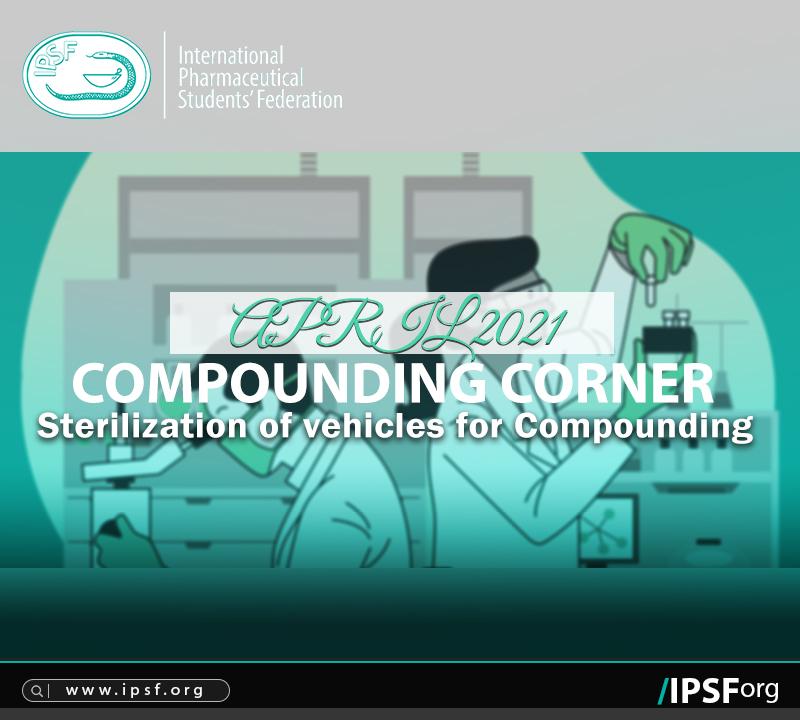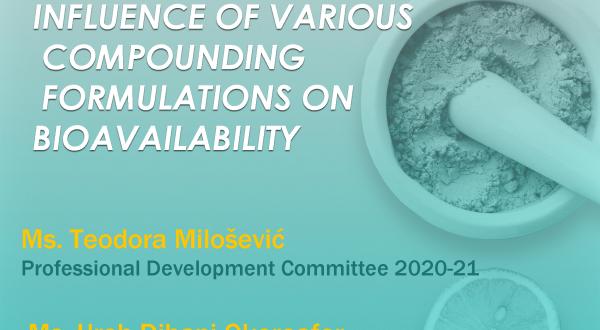
Sterilization of Vehicles for Compounding
By
Ms. Ureh Dibani Okoroafor
Compounding Event Coordinator 2020-21
And
Mr. Ismail Jomha & Ms. Rosa Sidiq
Professional Development Committee 2020-21
What are vehicles?
Vehicles for Pharmaceutical Compounding are substances of little or no therapeutic value that serve as solvent (or diluent) to the active pharmaceutical ingredient during formulation and/or administration. Examples of vehicles include water, alcohol, aromatic water, mineral oils, white petroleum etc.
Why do we sterilize the Vehicles?
Vehicles must be sterilized such that they possess some required characteristics such as: cleanliness and free from particulate matters, pharmacologically inertness, non-toxicity, non-sensitisation, non-irritation, compatibility with blood and/or serum, physical stability, stability in the medium despite anychange in pH.
Basically there are two major types of vehicles used in pharmaceutical preparations.
- Aqueous vehicles
- Non-Aqueous vehicles
Aqueous vehicles:
Water is the most common vehicle employed in pharmaceutical preparations and compounding. Water is used to dissolve medicaments, and also as co-solvents used to enhance solubility. Microorganisms can exist in water and liquids, especially during storage, therefore, the production of sterile water for pharmaceutical preparations and compounding must be encouraged.There are certain problems associated with preparation of water as a vehicle, these can be found during its collection, storage, and/or transportationWater intended for use in parenteral preparations should not only conform to high degree of physicochemical properties/purity but should also be free from pyrogenic substances as contaminants. Pyrogens in dissolved states, administered to the body during infusions have been known to cause febrile reactions. These pyrogens are water soluble, colorless, odorless, filtrable, thermostable and non volatile chemical substances of bacterial origin. The sources of these pyrogens include solvent, medicaments, apparatus used and method of storage.
As mentioned earlier, these pyrogens are thermostable and most of them will be resistant to increased temperature. They are also water soluble and even bacteria proof membrane filters cannot remove them from the solution. Pyrogens are not affected by the common bactericides since they are not organisms. They are non volatile and can only be successfully removed by trapping them from the distillate (during the distillation process to prepare pyrogen free material). During preparation of distilled water for injection, adequate measures should be taken to prevent contamination by bacteria. Depyrogenated water must be stored in well cleaned sterile containers and stored at a temperature unfavorable for bacterial and pyrogen growth, which are normally temperatures less than 10•C. The following preparation must be pyrogen free: water for injection, infusion fluid, fermentation product such as antibiotics (tetracycline, penicillin), animal product (heparin), protamine sulphate injection, substances given intravenously for diagnostic purposes (dyes, colourant). There are different tests to find out if a preparation is pyrogen free, such as the B.P. test for pyrogen (rabbit test), the in-vitro assay (limulus amoebocyte lysate assay), Chromogenic method, etc.
Water for injection :
As mentioned earlier, ordinary water cannot be used for preparation of water for injection. Distilled water that has been depyrogenated is appropriate for preparation of water for injection. When ordinary water is distilled for the purpose of injections, the first part of the distillate should be discarded, because it could contain dust and microorganisms. The receiving glass should be freshly sterilized by dry sterilization at 160•c for 1 hour. Once the distilled water is put in the recurved, it should be closed immediately when filled to prevent bacteria contamination.
Purified water BP :
The BP allows the use of a water purifier by ion exchange process for all purposes such as for the eye drops and other preparations, except for preparation of injections. This is due to the doubt of the efficiency of pyrogen removed by resins.
Water for injection free from CO2 and dissolved air :
The purified water is boiled for at least 10 minutes with minimum exposure to air. It is normally covered with an inverted flask and allowed to cool. It is used for preparation of certain injections such as theophylline injection and phenobarbital injection. The following should contain water for injection free from dissolved air: BP injection such as ergometrine injection, ergotamine injection, promethazine injection, apomorphine injection and tubocurarine e.t.c.
Non aqueous vehicle:
The vehicles are special oils, propylene glycol, some type of alcohol such as benzyl alcohol and ethanol. Some special oils include vegetable oil, benzyl benzoate.
Oils are used as vehicles for various reasons, such as when the medicament is not sufficiently soluble in water or not soluble in aqueous environment, when it is easily hydrolysed in an aqueous environment and when a slower release rate is required for the drug.
The oils must be of good quality and free from rancidity. Rancidity can be easily detected by odour, taste, or high acid content.
Oils to be used as vehicles should be extracted in a sterile environment, using aseptic techniques. Oils can be extracted by cold or hot expression, solvent extraction, centrifugation, or through fat obtained from tissue by steam with or without pressure. The method chosen depends on the nature and the intended usage of the oil.
There are certain quantitative tests that evaluate oils such as acid value/acid number, saponification value, ester value, iodine value, volatile acidity, unsaponifiable matter, reichert-meissl number, etc.
Suitable oils to be used as vehicles for injections
- Fixed oil esters: It must not contain paraffinic materials or hydrocarbons since these are not metabolized and may cause tissue damage or tumors.
- Arachis oil: This is commonly used for the preparation of oily injections but has the disadvantage of thickening slowly and eventually turns rancid. Arachis oil is suitable for Dimercaprol injection BP.
- Sesame oil: This oil is more stable than Arachis oil because it contains more antioxidants, making it a better option.
- Cotton seed oil: It is suitable for oily injections but has some vegetative contamination (gossypium).
- Maize oil: It has recently gained popularity and several studies are still required to authenticate its usefulness.
Some patients are known to have allergic reactions to certain oils used in oily injections, therefore it is important for all oily injections to contain a label to indicate the type of oil used.
All vehicles are to be sterilized by filtration sterilization method. This method is unique among sterilization methods in that it removes, rather than destroys microorganisms. Filtration sterilization ensures that all viable and non-viable cells are removed from the solution. The major mechanisms of filtration are sieving, adsorption and trapping within the matrix of the filter material.
The primary aim of this method is to physically remove bacterial cells and spores from liquids by means of filters. These filters must have pores that are small enough to remove bacterial cells and spores. A filter with a pore size of 0.22µm will effectively remove bacteria. As for viruses, a much smaller pore size of around 20nm is needed.
Solutions filter slowly through membranes with smaller pore diameters.
The filtration equipment and filters may be purchased as pre-sterilized disposable units in sealed packaging or must be sterilized by the user (if not pre-sterilized), by autoclaving at a temperature that does not damage the fragile filter membranes.
Also to ensure sterility, the filtration system must be tested to ensure that the membranes have not been punctured prior to or during use. To confirm the integrity of filters before and after filtration, a bubble point or similar test should be used, in accordance with the filter manufacturer's instructions. This test employs a prescribed pressure to force air bubbles through the intact membrane previously wetted with the product, with water, or with a hydrocarbon liquid.
Filters such as asbestos filters, porcelain filters, and siliceous filters of 0.2- 0.22µm pore size diameter are used to achieve high microorganism removal efficiency while sintered filters are used only for the processing of corrosive liquids, viscous fluids or organic solvents.
Reference:
Muchuelas J (2014). Non Aqueous Vehicles. Available at https://prezi.com/qjpev3d6_viv/non-aqueous-vehicles/
Solanki H (2017). Vehicles used for pharmaceutical preparations. Available at https://www.slideshare.net/HITARTHSINHSOLANKI/vehicles-used-for-pharmaceutical-preparations
Filtration Sterilization - Sterilization Methods. Available at
http://www.pharmacy180.com/article/filtration-sterilization---sterilization-methods-639/



